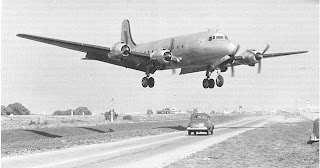This is a typical airplane with a nosewheel, a Cessna 172:

This is an airplane with a tailwheel, a Cessna 170:

The big advantage of a nosewheel is that they are dynamically stable on the ground. For reasons involving physics and stuff like that there, a wheeled craft is stable if its center of gravity is behind the steering wheels. You can test this for yourself, if you wish. The next time you go to the supermarket, find a shopping cart that has decent wheels. Stand behind the cart and give it a push, you will see that the cart tends to roll straight. Then stand in front of the cart and give it a push, you will see that the cart tends to turn and, it it rolls far enough, it will swap ends so that it rolls front first.
Airplanes will do the same thing. When taxiing, taking off and landing, an airplane with a nosewheel will tend to roll in a straight line without the pilot doing anything about it. A tailwheel airplane requires the constant monitoring and correction by the pilot to keep it rolling straight (though an experienced pilot may be doing this without thought). A tailwheel airplane that swaps ends has executed a "groundloop." Depending on the speed of the groundloop, one can collapse one or both legs of the main gear and smash a wingtip into the ground. A really bad one can result in overturning the airplane.
Nosewheels have disadvantages. First off, they add weight, 15-20lbs over a tailwheel, which is why in some high-performance applications, such as competition aerobatics, tailwheel airplanes rule. They are also more complex than tailwheels, so there is more to maintain and more to break. Third, on airports with grass or rougher surfaces, a nosewheel can dig in and the result can be a broken or bent propeller. The latter reason is why airliners in the 1930s had tailwheels, as even airports that had airline service tended to be grass or cinder fields. The DC-3 was probably the last widely-used airliner with a tailwheel.

Crosswinds were not much of a problem in the old days; airports were often just large fields and you could land into the wind. The Navy did pave their airports in the 1930s, but they had "landing mats", which were large paved circles about 1,500' across. Because aircraft carriers turn into the wind, the Navy evidently thought it not worth the effort to make sure its pilots had to deal with crosswinds when on shore.
That all changed when, in World War II, a lot of airports were paved. (The widespread construction of airports also dealt a death blow to the use by airlines of flying boats.) Airliners started to have nosewheels. Nosewheels are for paved runways.
The DC-4 had a nosewheel:

Nosewheels are nice to have on the occasion when you have to make a landing in a strong crosswind. Airplanes want to fly straight into the wind; when you land in a crosswind, the airplane will want to turn on the runway. But because nosewheels make the airplane roll straight, that helps counter the crosswind.
One thing that a lot of pilots forget is that nosewheels are not "landing gear" in that you aren't supposed to land on them. You are supposed to land on the main wheels and, as the airplane slows, then lower the nose. When you see an airplane land and it lands in either a flat attitude or the nosewheel bangs onto the runway a second after the main wheels, that is sloppy technique.
Worse, you will sometimes see an airplane land and, because it is going too fast, the pilot pushes the control wheel forward to hold it on. In a really bad case, the mainwheels will leave the runway and the airplane rolls on the nosewheel along. This is called "wheelbarrowing" and it is extremely bad form. Nosewheels are not designed to do this.
There are some airplanes that will punish you if you land them like that. The Cessna 182 is a prime example; if you wheelbarrow one, you will, sooner or later, put enough force on the points where the nose gear attaches to the aircraft that you will wrinkle the firewall. Or worse.
So don't go brain-dead on landing once the mains touch; keep the control wheel coming back and keep the nosewheel off the runway until the airplane has slowed down. If you fly one type enough, you'll know when to lower the nose (before the elevator stalls out).
Tailwheel airplanes require a bit more skill to land and operate on the ground. Flying one can be a bit of bragging. And, for a time, until it became fashionable to fly them, tailwheel airplanes were a lot cheaper to buy.
I bought mine because, at the time I bought it, I needed an airplane that I could take into a certain grass strip. On a grass strip, the "grabbiness" of the grass tends to cancel out the tendency of a tailwheel airplane to perform a groundloop. Tailwheel airplanes are just better on grass. Which is why these two Stinsons just look at home on the grass.

I'll write my thoughts on the two methods of landing a tailwheel airplane at another time. Right now, it is a nice day and the sky is calling.











4 comments:
Looking at the two Cessna's at the top, at first glance, the only noticeable difference is of course, the landing gear, and then the rear vertical rudder.
On closer inspection, I see that there is a difference in the fuselage right behind the wing also.The 172 obviously being a newer version.
I like the 170. It is ,how do I say this, classier looking , to me.I like the rounded tail and the nose is cleaner without the nose wheel.
I wouldn't have the faintest idea on how to operate either one, but I know what I like.I prefer older machines that function well.
They are usually better built and almost always have better lines.
I'm just weird like that I guess.
Learned a lot. Fun post to read. A good friend who is an ag pilot experienced an engine failure this summer on a motor with less than a 100 hrs. A rod went through the crankcase on the top side but stayed running for him to get over an oncoming highline wire. Windshield obscurred he set down in a bean field. Corn will save you but beans kill you because they snag the wheels. Close to ground looked out the door and was able to straddle the rows. Jerome is a hell of a pilot.
The link below is about one hell of a landing that happened in Aspen. I'll fly with this guy any time in the mountains.
http://cbs4denver.com/local/aspen.landing.safe.2.619038.html
Busted, the 172 is a L model. If you look at a photo of a early 172, the lineage is apparent.
One fly, the link didn't work, but I presume that was the story about the guy who dead-sticked a Piper Malibu?
Malibus have engine problems. They are nice, roomy airplanes, but the engines are nowhere near as reliable as, oh, just about anything made since 1945.
dead sticked from 8 miles out at Aspen because the propeller broke. yea probably that one.
Post a Comment